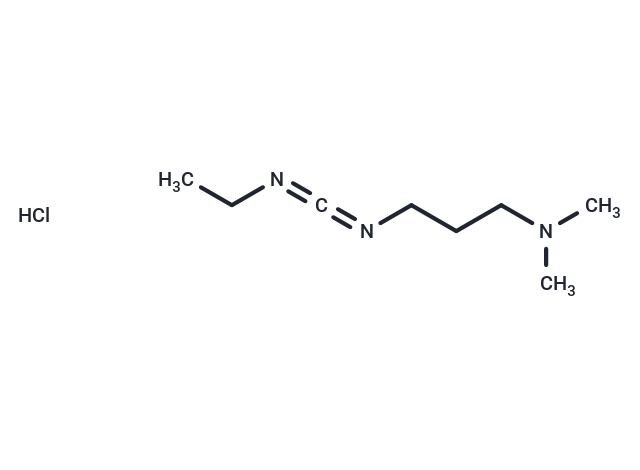 Your shopping cart is currently empty
Your shopping cart is currently empty

EDC hydrochloride (EDC-HCl Crosslinker) is a water-soluble carbodiimide compound. EDC hydrochloride, as a condensing agent, forms peptide bonds through the condensation reaction of carboxyl and amino groups and can be used to synthesize peptides with specific sequences and functions. EDC hydrochloride can covalently bind haptens to carrier proteins to form immune antigens, which are used in vaccine research. EDC hydrochloride can react with the 5 'phosphate group of nucleic acids and is used for the labeling of DNA and RNA. EDC hydrochloride can cross-link proteins with nucleic acids and is used to prepare immune cross-links. EDC hydrochloride, as a crosslinking agent, connects the amine-reactive NHS ester of biomolecules with the carboxyl group, which can be used for protein coupling to create hybrid molecules with new properties and functions.

| Pack Size | Price | USA Warehouse | Global Warehouse | Quantity |
|---|---|---|---|---|
| 10 g | $32 | - | In Stock |
| Description | EDC hydrochloride (EDC-HCl Crosslinker) is a water-soluble carbodiimide compound. EDC hydrochloride, as a condensing agent, forms peptide bonds through the condensation reaction of carboxyl and amino groups and can be used to synthesize peptides with specific sequences and functions. EDC hydrochloride can covalently bind haptens to carrier proteins to form immune antigens, which are used in vaccine research. EDC hydrochloride can react with the 5 'phosphate group of nucleic acids and is used for the labeling of DNA and RNA. EDC hydrochloride can cross-link proteins with nucleic acids and is used to prepare immune cross-links. EDC hydrochloride, as a crosslinking agent, connects the amine-reactive NHS ester of biomolecules with the carboxyl group, which can be used for protein coupling to create hybrid molecules with new properties and functions. |
| Targets&IC50 | lysine:500 µM |
| In vitro | METHODS: Human fibroblasts were treated with EDC hydrochloride (0, 4, 8, 16, 24 mM) for 4, 6, and 24 hours, and the detection showed the cell survival rate. RESULTS: The cell survival rate decreased in a time-dependent manner with the concentration of EDC hydrochloride. |
| In vivo | METHODS: To study the effect of EDC hydrochloride on neurological function, EDC hydrochloride (0.0075%, once) was intramuscular injected into adult male Swiss Webster mice. RESULTS: EDC hydrochloride does not cause neurological deficits after injection. [1] |
| Synonyms | EDC-HCl Crosslinker, 1-(3-Dimethylaminopropyl)-3-ethylcarbodiimide hydrochloride |
| Molecular Weight | 191.7 |
| Formula | C8H18ClN3 |
| Cas No. | 25952-53-8 |
| Smiles | Cl.CCN=C=NCCCN(C)C |
| Relative Density. | 0.877 g/cm3 at 20℃ (lit.) |
| Color | White |
| Appearance | Solid |
| Storage | keep away from moisture | Powder: -20°C for 3 years | In solvent: -80°C for 1 year | |||||||||||||||||||||||||||||||||||
| Solubility Information | H2O: 30 mg/mL (156.49 mM) DMSO: 245 mg/mL (1278.04 mM), Sonication is recommended. | |||||||||||||||||||||||||||||||||||
| In Vivo Formulation | 10% DMSO+40% PEG300+5% Tween 80+45% Saline: 5 mg/mL (26.08 mM), Sonication is recommended. Please add the solvents sequentially, clarifying the solution as much as possible before adding the next one. Dissolve by heating and/or sonication if necessary. Working solution is recommended to be prepared and used immediately. The formulation provided above is for reference purposes only. In vivo formulations may vary and should be modified based on specific experimental conditions. | |||||||||||||||||||||||||||||||||||
Solution Preparation Table | ||||||||||||||||||||||||||||||||||||
H2O/DMSO
| ||||||||||||||||||||||||||||||||||||
| Size | Quantity | Unit Price | Amount | Operation |
|---|

Copyright © 2015-2025 TargetMol Chemicals Inc. All Rights Reserved.